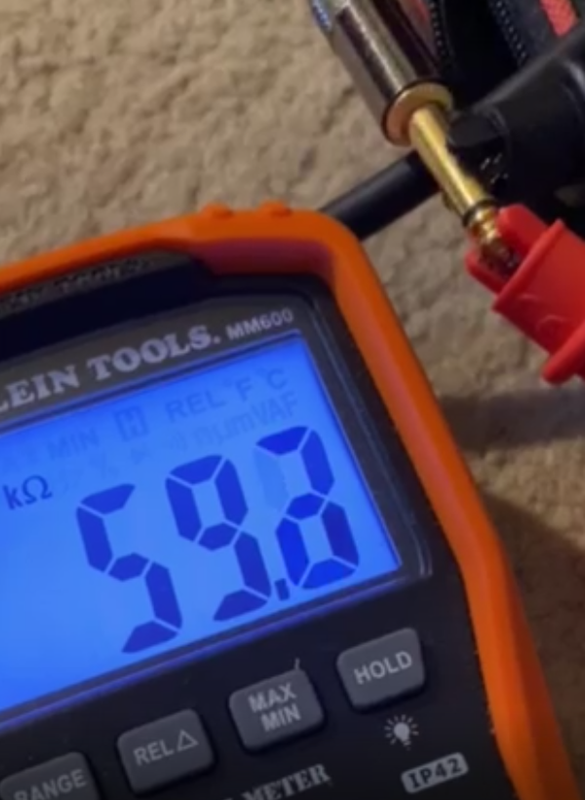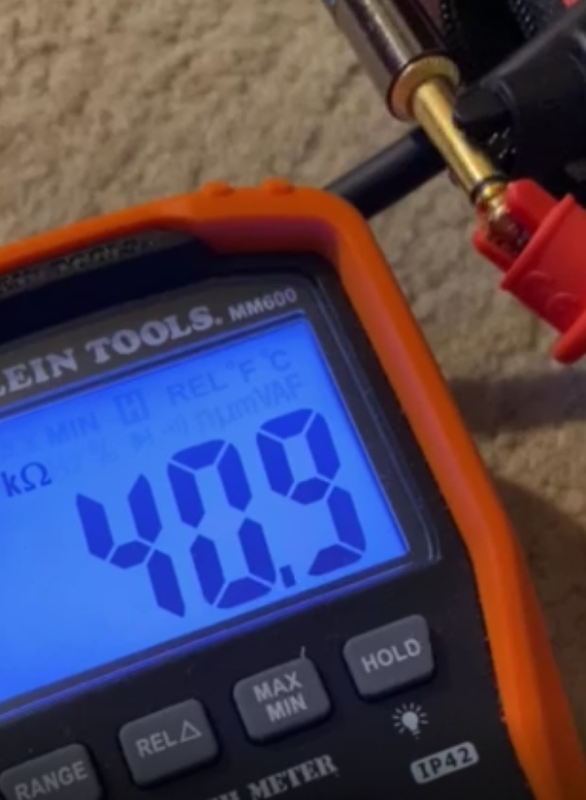|
|
Post by unreg on Feb 19, 2022 18:37:17 GMT -5
Anyways, thank you sumgai! 😀 EDIT: I will measure my current resistance value on my Tone pot, record that, and then find the new sweet spot with a new 250K Tone pot and record that. Thank you. 😊 I'm having a problem recording a resistance value from my current Tone pot... recorded a video of my multimeter screen; at 15sec it shows the value:  (^the numbers are changing so fast that the last digit appears weird) and then near the video's end it drops to:  And, at the video end, it has risen back to 48.9K ohms. So, what value should I record. Or, what am I doing wrong?  |
|
|
|
Post by sumgai on Feb 19, 2022 20:09:59 GMT -5
Klein usually makes some pretty decent tools, so I won't go down that path just yet. I see that you've clamped the meter leads onto a guitar cord with alligator clamps. I must assume that the other end of the cord is plugged into the guitar, correct? Then I also must assume that your axe completely untouched (nothing is unsoldered), that it's ready to rock out, yes? If that's the case, then you are not measuring the Tone pot at all, you're instead measuring some/all of the remaining internal components. That's because the cap on the Tone pot blocks DC (the battery voltage inside of the meter, which is needed in order to read a resistance). If your goal is to measure the Tone pot, then you'll have to open up your rig and disconnect the Tone pot from the circuit. Just unsolder the cap and take another measurement - it should read pretty close to the stated value (usually 250K or 500KΩ). Don't forget that these things come with a 20% tolerance, so don't jump to the conclusion that the part is way-off-base until you do a bit of math.  HTH sumgai |
|
|
|
Post by ashcatlt on Feb 19, 2022 20:15:09 GMT -5
Is the other end of that cable plugged into the jack? You can’t measure a T pot that way. The meter applies a DC voltage, which can’t flow through the capacitor. What usually happens when you measure DCR through a cap is the value will start very low and rise as the cap charges up and eventually approach infinity. Of course that whole thing is in parallel with about everything else in the guitar, so as the cap starts to look big, you end up just measuring the parallel total of that other stuff. Now, if the V pots are all the way up, I’d expect it to read something close to the DCR of whichever pickup is selected.
Most components want to be removed from the circuit - at least disconnected at one end - before you measure them. In the case of a T pot, it basically is disconnected at the one end, so if you actually get in there and measure from the “inside” of the cap, you could probably get a rational reading.
|
|
|
|
Post by unreg on Feb 19, 2022 21:05:44 GMT -5
Yes, that cable’s other end is plugged into the jack of my “ready to rock” guitar. 🥳 Thank you sumgai and ashcatlt!  The meter applies a DC voltage, which can’t flow through the capacitor. Now I remember reading ChrisK saying something like caps only accept AC. However, I don’t understand y’all’s desoldering the cap first advice; didn’t even know my tone pot had a cap. …Or, maybe it’s that thin flat green thing (that newey taught me about)! Ok, I think I understand you now. 👍 Will first find newey’s words, and then CORRECTLY measure my Tone pot’s resistance.  Thank you both so much!  |
|
|
|
Post by ashcatlt on Feb 19, 2022 21:33:37 GMT -5
Note that I didn’t say to desolder anything. In this one specific case, the capacitor itself isolates the pot from the circuit so that all you need to do is measure the pot itself. One or the other of the connections from the jack is “outside” the cap - current has to go through it to get to the pot. Measure “inside” the cap, and you’ll be fine.
|
|
|
|
Post by unreg on Feb 21, 2022 0:17:22 GMT -5
Thank you ashcatlt!  After placing black on Tone lug 2 and then red on Tone lug 1, both tips touching “inside” the cap, I receive a solid 238.8 or 238.85 Kohms. Did I place the multimeter tips to the correct lugs? Haven’t unsoldered anything. According to the potentiometer orientation thread, lug 1 is CCW lug and lug 2 is wiper. |
|
|
|
Post by newey on Feb 21, 2022 6:25:09 GMT -5
If the pot was full on, that should give a fairly accurate result. Typically, to measure the pot's value, test between 1 and 3.
But 238KΩ is solidly within the expected variance for a 250K pot
|
|
|
|
Post by unreg on Feb 24, 2022 9:49:57 GMT -5
Hmm ~247.85K ohms seems to be my Tone pot’s “perfect” setting. That value was obtained with multimeter’s black tip on Tone lug 1 and red tip on Tone lug 3 (tips “inside” the cap). That higher value will be ok bc my new CTS 250K tone pot, from guitarelectronics.com, is 255.1K when measured, while set at at max volume, under identical multimeter settings.  PRAISE GOD!! 😃 POINTLESS(?) EDIT: guitarelectronics.com/cts-250k-audio-taper-pro-guitar-pot-w-long-brass-shaft/pointless bc all pots are different… however this is a CTS PRO pot, so it’s guaranteed to be +/- 10%. |
|
|
|
Post by newey on Feb 24, 2022 11:25:38 GMT -5
so it’s guaranteed to be +/- 10%. On a 250K pot, that means it could be anywhere from 225K to 275K. Most guitar mfrs use parts with 20% tolerances so the range is even wider in theory. But there isn't going to be any audible difference with such small variations in resistance as you are measuring. |
|